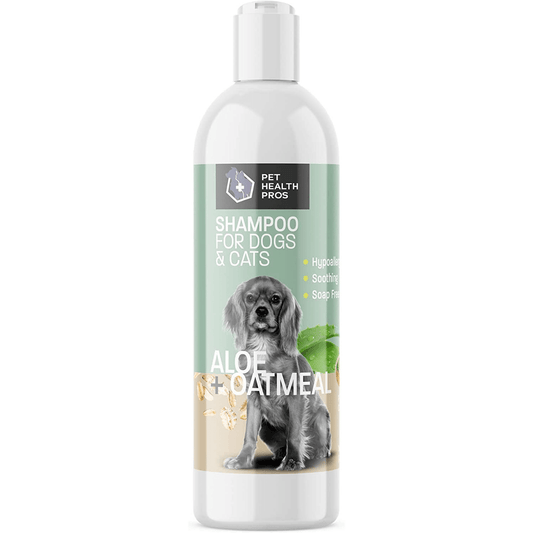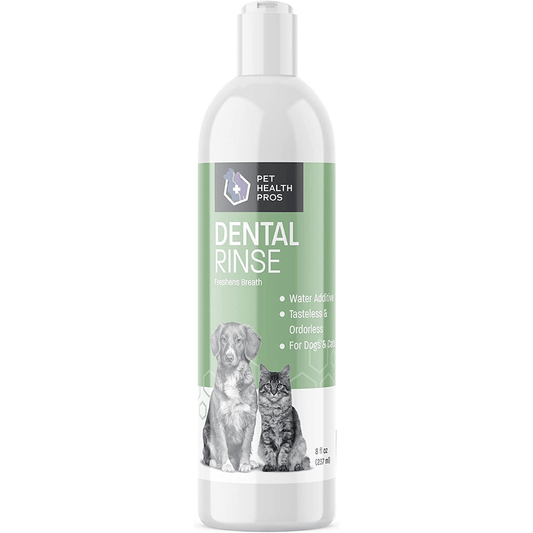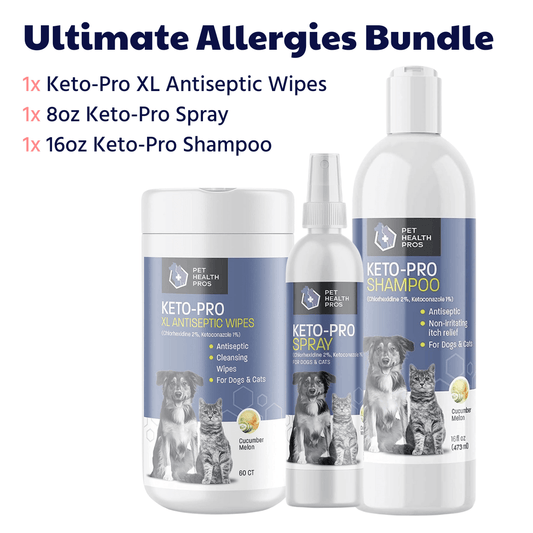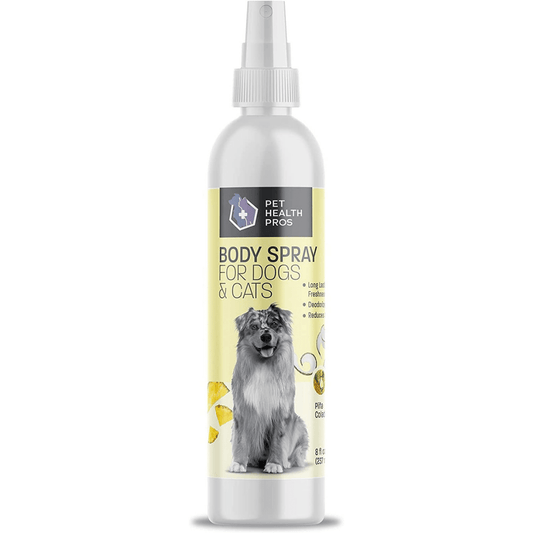Ringworm, a word that brings unease to any dog owner, is often shrouded in misconceptions. Embark on a clearer path, understanding the intricacies of dog ringworm and the power of comprehensive treatment, heightened through the specialized care products of Pet Health Pros.
To demystify dog ringworm, provide a comprehensive treatment guide with solutions for hot spots, treatment, remedies, and cures. Understand what dog ringworm is and identify its symptoms.
What is dog ringworm?
Dog ringworm, also known as dermatophytosis, is a contagious fungal infection. It affects the skin, hair, and nails of dogs. Fungi called dermatophytes cause it. These fungi feed on the keratin in the outer layers of the skin. This leads to circular patches of hair loss, redness and scaling. Contact with an infected dog or contaminated objects like bedding or grooming tools can spread the infection.
The symptoms vary depending on severity. Small areas of hair loss with little redness and itching can appear in mild cases. Severe infections cause bigger lesions with intense itching and inflammation. Not all dogs show symptoms even if they're carriers of the fungus.
To diagnose, vets may use a Wood's lamp exam or a culture test. The Wood's lamp emits ultraviolet light to make some fungi appear fluorescent. A culture test involves collecting samples from the affected area and growing them in a lab.
Treatment usually involves topical antifungal meds, oral meds and environmental decontamination. Following vet instructions is important for successful treatment and to prevent spread.
In ancient times, people thought worms lived under the skin and caused it. Herbal remedies and burning with hot irons were used for treatment. Now, our understanding of ringworm has improved, leading to more effective treatments and prevention methods.
Symptoms of dog ringworm
Ringworm is a frequent fungal infection that affects dogs. It has five primary signs:
- Red, circular marks on skin
- Patchy hair loss
- Scaly patches
- Itching
- Inflammation
In some cases, an overactive immune system can cause the irritation to be more intense.
It can be difficult to diagnose as these symptoms are common in other conditions. If you see any of these signs with your pup, it's important to speak to a vet right away.
My neighbor had a dog with ringworm. She started to have hair loss and red spots. Initially, they thought it was just an allergy, but it got worse. After consulting a vet, they realized it was ringworm. With medication and care, the pup recovered and got her glossy coat back.
This case highlights how essential it is to identify and treat ringworm quickly. Early detection can spare our furry friends from distress and guarantee their wellbeing.
Understanding hot spots
To understand hot spots in dogs and how they relate to dog ringworm, explore the causes behind hot spots. Discover the correlation between hot spots and dog ringworm.
Causes of hot spots
Hot spots, or heat islands, are hotter than their surrounding areas. Urbanization, human activities, and geographical factors all contribute to their formation.
Concrete and asphalt in cities absorb and retain heat from the sun, causing temperatures to rise. Also, without vegetation, evaporation cannot cool things down.
Industries and vehicles emit heat-trapping gases such as carbon dioxide and methane, intensifying local temperatures. Certain regions may be more prone to extreme temperatures due to topography or bodies of water nearby.
We can address these causes to better human health and the environment. Planting more vegetation and implementing green infrastructure initiatives can help cool cities. Additionally, reducing greenhouse gas emissions through sustainable practices can reduce global temperatures and consequently, hot spot conditions. Urban planning strategies that focus on heat mitigation solutions like cool roofs or reflective pavements can also help reduce surface temperature.
How hot spots relate to dog ringworm
Hot spots and dog ringworm may appear unrelated, but they're connected. Hot spots, or pyotraumatic dermatitis, are moist, infected skin sores that occur in dogs with weakened immune systems or poor hygiene. These spots create a perfect habitat for the fungus, Microsporum canis, responsible for dog ringworm.
The dog's constant scratching and licking of the area damages the skin's protector, allowing M. canis to enter and create an infection. The warm and wet environment of the hot spot helps spread the fungus.
To stop hot spots from worsening or becoming homes for ringworm, you must act fast. Keep your pup's coat clean and groomed to minimize bacterial and fungal growth. Check your pup's skin for signs of redness and irritation.
If you spot a hot spot, see your vet right away. Treatments usually involve cleaning the area, shaving the fur around it and applying topical meds or antibiotics. Your vet may suggest an Elizabethan collar to stop scratching or licking.
By addressing hot spots quickly and managing them correctly, you can reduce the risk of dog ringworm. Prevention is the key to keeping your furry friend happy and healthy!
Comprehensive treatment options for dog ringworm
To effectively address the comprehensive treatment options for dog ringworm and find the right solutions for your furry companion, delve into veterinary prescribed treatments, natural remedies for dog ringworm, and preventive measures to avoid this pesky condition. Discover the best approaches to ensure your dog's health and well-being.
Veterinary prescribed treatment
Veterinarians often give oral antifungal meds, like terbinafine or griseofulvin, to treat ringworm in dogs.
Topical antifungal creams or ointments can be applied to the affected areas to help recovery.
Bathing with antifungal shampoo is essential to remove spores and reduce risk of reinfection.
Clean and disinfect the dog's environment to stop spread. Vacuum, wash bedding, use antifungal sprays.
Infected dogs need to be kept separate. Isolate them until cleared by vet.
Regular check-ups with vet are important throughout treatment process.
Factors like severity and health can influence individualized care.
Pro Tip: Follow vet instructions precisely when administering meds or treatments. Consistency and hygiene are key for a successful outcome.
Topical ointments and creams
Topical ointments and creams are a great way to treat your pup's ringworm! They contain antifungal agents that fight the infection and help your pup heal. Popular options include miconazole, clotrimazole, and terbinafine creams. Easily found at pet stores or through a vet.
To get the best results, it's important to follow directions. Clean and dry the affected area before applying the medication twice a day. Don't stop using it even after symptoms are gone, to prevent recurrence.
Not only are topical ointments and creams effective, they offer convenience for pet owners. But, if your pup has a severe or widespread infection, speak with a vet for more advanced treatment options.
Help your pup feel better fast! Incorporate topical ointments and creams into their plan. Early intervention is key to avoiding discomfort. Reach out to your vet to explore these options further.
Oral medications
Oral meds are a vital part of treating dog ringworm. They work internally, fighting off the fungal infection from within.
A popular oral medication is itraconazole, which belongs to the azoles group of antifungal drugs. It halts the growth of the fungi causing the ringworm. It comes in either capsule or liquid form and is given once or twice daily, depending on severity.
Terbinafine is another useful oral medication. It's an allylamine antifungal and works by stopping the fungi from making cell walls. It's normally taken once a day, and treatment duration may vary.
Always get these meds from a vet, after a thorough examination and diagnosis. Also, they may have side effects, so close monitoring is essential.
Natural remedies for dog ringworm
Natural remedies can be a great alternative when it comes to treating dog ringworm. They provide relief and encourage healing in a natural way. Here are 3 that work well:
- Apple Cider Vinegar - It has antifungal properties. Dilute it with water and apply it directly to the affected area with a cotton ball or spray.
- Tea Tree Oil - This oil has strong antifungal abilities. Mix a few drops with carrier oil (e.g. coconut oil) and apply to the area twice daily.
- Aloe Vera - Known for its soothing properties, this can help lessen itching and encourage healing of the skin. Apply fresh aloe vera gel to the area several times a day.
It's also essential to keep proper hygiene and cleanliness to avoid spreading ringworm. Clean your dog's bedding and toys regularly.
Historically, natural remedies have been used to treat various conditions, including dog ringworm. Ancient people believed in utilizing nature to heal their beloved pets. And these remedies still hold value today, providing a different way to manage dog ringworm and promote overall well-being.
Apple cider vinegar solution
Apple cider vinegar is an increasingly popular solution for dog ringworm. Here are some points to consider:
- It's a natural antifungal.
- Dilute it with water and apply it to the affected areas with a cloth or cotton ball.
- Its acidity stops the fungus from growing and helps healing.
- It can also relieve symptoms like itching, redness and inflammation.
Plus, it has been used since ancient times for its health benefits. It has antimicrobial, anti-inflammatory and antioxidant properties, which can be good for wellbeing.
Since long ago, people have known of its power to treat fungal infections, such as ringworm. This speaks to the effectiveness of the solution.
Tea tree oil application
Tea tree oil is an effective way to treat your pup's ringworm. Here's a 4-step guide for using it:
- Clean the area: Wash it with mild soap and water. This will help the tea tree oil work better.
- Dilute the oil: Mix one part tea tree oil with ten parts carrier oil, such as coconut or olive oil.
- Apply the mixture: Use a cotton ball or clean cloth to put the diluted oil on the affected area. Gently massage it in.
- Repeat twice daily: Do this twice a day until the ringworm is gone. Keep an eye out for any bad reactions.
Note that tea tree oil has antifungal properties and can help get rid of the infection causing the ringworm. But, always ask your vet before using any home remedies on your pup's skin.
Preventive measures to avoid dog ringworm
To avoid dog ringworm, preventive measures are key. Make sure to take precautions on time and protect your pooch from this contagious fungal infection. Here's a five-step guide:
- Maintain hygiene: Bathe and groom your pup often to keep their skin clean.
- Keep living area clean: Clean and disinfect their bedding, toys, and other items.
- Avoid contact with infected animals: Minimize your dog's exposure to infected animals.
- Boost their immune system: Feed them a balanced diet, offer exercise, and consider supplements your vet recommends.
- Regularly vet check-ups: Have routine check-ups to detect any skin issues and treat early.
Reminder: Prevention is better than cure! Following these steps can decrease the chances of your pup getting ringworm. If you suspect an infection or see changes in their skin, seek professional advice. Quick action will ensure proper treatment and speedy recovery for your furry companion. Take care of your canine friend!
Regular grooming and cleaning
For successful treatment of dog ringworm, regular grooming and cleaning are essential. This helps prevent the spread of infection, maintain hygiene and support healing. Some tips to consider:
- Brush your pet's coat regularly to remove any infected hairs and stop further contamination.
- Wash their body with a medicated shampoo recommended by the vet, focusing more on the areas affected.
- Dry them thoroughly after each bath as moisture boosts fungal growth.
- Clean and disinfect all grooming tools like brushes, combs and clippers.
- Vacuum carpets and furniture regularly and wash bedding in hot water to keep ringworm spores at bay.
Moreover, avoid harsh chemicals and don't over-bathe your pet as this can irritate their skin. Also, wear gloves while handling them to reduce the risk of transmission.
Regular grooming and cleaning for dog ringworm are extremely important. They help prevent infection, ensure wellness and form a part of the comprehensive treatment plan. So, make sure to prioritize them for your beloved pet.
Ensuring proper nutrition and diet
Nutrition and diet are key when treating dog ringworm. A balanced diet can help the body fight the infection. Here's what to consider:
- Feed your pup high-quality food with proteins, vitamins, and minerals.
- Include fresh fruits and veggies for antioxidants and vitamins.
- Avoid food that could trigger allergies.
- Add supplements like fish oil or probiotics for overall health and immune system support.
- Keep a consistent feeding schedule and don't overfeed to avoid obesity.
Every dog has unique dietary needs. Talk to a vet for tailored advice.
Pro Tip: Provide lots of fresh water for hydration and toxin flushing.
Conclusion
Ringworm need not be an endless journey for your dog. With Pet Health Pros, find not just a treatment, but a promise of health restored, ensuring your dog's comfort and happiness.
Searching for a reliable dog hot spot remedy has led us here! We've decoded the mysteries of dog ringworm for you. Medicated shampoos and creams can treat it. Cleaning and grooming the area helps heal it. For a natural remedy, mix tea tree oil and coconut oil. But, test it first. Max battled dog ringworm and won! His owner followed treatment. With time and care, he conquered it. To treat it, knowledge and persistence are key. Use our guide and lead your pet to a happy, itch-free life.
Frequently Asked Questions
FAQ 1: What is dog ringworm?
Dog ringworm refers to a fungal infection that affects the skin, hair, and nails of dogs. It is not actually caused by a worm but rather by a group of fungi called dermatophytes.
FAQ 2: How can I identify ringworm in my dog?
Ringworm in dogs often appears as circular or irregular patches of hair loss with red, scaly, or crusty skin. The affected areas may be itchy or inflamed. It's important to consult with a veterinarian for a proper diagnosis.
FAQ 3: What are the hot spots associated with ringworm?
Hot spots, also known as acute moist dermatitis, can be a secondary infection caused by a dog scratching and biting at the itchy ringworm lesions. These hot spots are areas of inflamed and infected skin that require appropriate treatment.
FAQ 4: How is ringworm in dogs treated?
Treating ringworm in dogs typically involves a combination of topical antifungal medications, oral antifungal medications, and environmental decontamination. It's important to follow the treatment plan prescribed by your veterinarian to ensure effective eradication of the infection.
FAQ 5: Are there any natural remedies for dog ringworm?
While natural remedies may provide some relief or support for the treatment of ringworm, they are unlikely to completely cure the infection. It's crucial to consult with a veterinarian to determine the most appropriate and effective treatment options for your dog.
FAQ 6: Can ringworm in dogs be cured?
Yes, ringworm in dogs can be cured. With proper and consistent treatment, most cases of ringworm can be completely eradicated. It's essential to adhere to the treatment plan, maintain good hygiene practices, and follow up with veterinary visits to ensure the infection is fully resolved.








